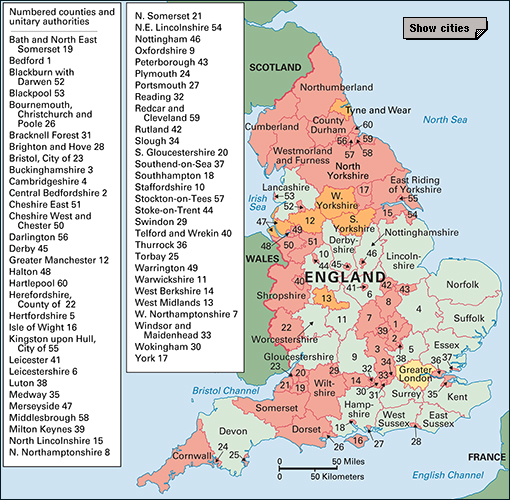Bedfordshire is a ceremonial county in the southeast midlands of England. Before the 1900’s, it was mainly rural and agricultural, but factories replaced much of the former farmland. Bedford, the county’s former administrative center, is an important center of industry. In the early 2000’s, Bedfordshire was divided into three unitary authorities (local government areas): the boroughs of Bedford and Luton and the district of Central Bedfordshire.

Archaeologists have found much evidence of prehistoric settlements in Bedfordshire. Soon after 500 B.C., early Iron Age people began farming the area, building forts along the chalk hills for protection. The Romans later set up a posting station, which they named Durocobrivae, at Dunstable, where Watling Street crosses the Icknield Way. Later, the Angles and Saxons settled in the county. Their cemeteries are at Kempston, Sandy, Totternhoe, and Leighton Buzzard. During the reign of King Alfred, the Danes occupied part of Bedfordshire. Dunstable was founded by King Henry I in the early 1100’s. He set up an Augustinian monastery there. Henry III, in the 1220’s, besieged and demolished Bedford Castle.
The author John Bunyan was born at Elstow, near Bedford, in 1628. He spent 12 years in prison at Bedford, where he began to write The Pilgrim’s Progress. He lived in Bedford after his release. Bunyan is buried at Bunhill Fields. Admiral Byng, who was found guilty of neglect of duty in action and executed in 1757, is buried at Southill Church. John Howard, who campaigned to improve prison conditions in the 1770’s, lived most of his life at Cardington.
Many of the Dukes of Bedford played influential roles in the histories of the county and the country. Lord John Russell, a prominent politician in the mid-1800’s, was twice prime minister.
Some ancient traditions survive strongly in Bedfordshire. Ickwell Green, near Biggleswade, has a tall maypole that is used for dancing every May Day (May 1). An unusual ceremony takes place in Leighton Buzzard on Rogation Monday (the Monday before Ascension day). At some almshouses (charitable houses) in the town, a choirboy stands on his head while part of the will of the houses’ benefactor is read. The benefactor, Edward Wilkes, set up the houses in 1630.
